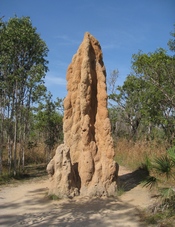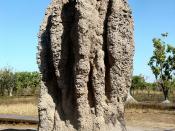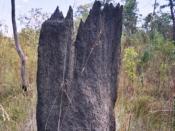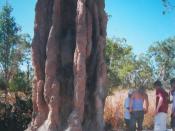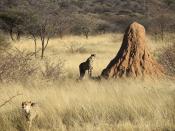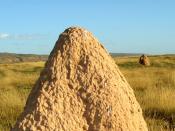Termite Mound is found on Stuart Highway near Darwin in northern territory, Australia. Termite mounds aren't just found in Australia, thy are found all over the world. The most common places are Brizil, Africa, and Australia. Termite mounds are found in dry tropical habitats.
The purpuse and function of a termite mound is to maintain the tempeture, gas balance, and humidity. The cone shaped temite mound is both fortress and air conditioner for the termites. The termites use the mound to culterate fungis gardens. The termites tend to their gardens.
Sientists believe that the Cathedral Termite Mound was started over one hundred years ago, but don't know for sure. By the 1950s the Cathedral Termite Mound was found in a state of decay. As the colony grows so does the mound. The mounds that are extremely large have more than five million termites within them. Termite mounds have long life sands that are measured in centuries.
Old trees associated mounds suggest this.
The major materials used to make a termite mound are, termite suliva, termite dung, grass, wood, and dirt. The termite constucts its mound by cementing those objects together with suliva then the mound it bakes in the sun. When done, the termite mound can be as strong as cement. For a softer material, a termite can chew up a bit of plant and mix it with suliva to aline the inner walls of the tunnels.
These termite structures are very unique because of their size and shape. They are also unique because of the creatures that made them. Each termite in the colony, besides the queen weighs less than a thousandth of an ounce each. Termite mounds grow in various sizes reaching 23 feet (7meters) to 43 feet (13meters). The most popular shapes are domed shaped, pyramid shaped, and some with chimneys rising 30feet (9meters). The termite mounds are water tight and very strong. A pickaxe or hammer is needed to break a mound open. Termite mounds are simular to icebergs because all you can see is the top but the bottom continues underground. There is no cost involved in building the mound, except the hard labor of the termites.
The Cathedral Mound is famous for its shear size and majesty. The Cathedral Mound is also famous because it could be more than 100 years old. Because termite mounds don't seem to have regular growth rings, its age cannot be exactly determined. Other termite mounds in the top end of Northern Australia have distinctive features of a number of dry tropical habitats.
The challenges faced by the termite architects/engineers were that the worker termites were blind, and had to construct the mound one spitball add a time. Another challenge faced by the termite, was that they weighed less than a thousandth of an ounce.
The history of the Cathedral Mound of the Sphinx termite is that it had to be "topped"ÃÂ when the Overland Telegraph was constructed because it interfered with the wires. In general, the history of termite mounds is that they are the oldest type of organized community on earth. They also offer protection from predators and are used as shelter. Termites are historically useful ecologically. They recycle the nutrients in dead wood and the microorganisms in their intestines transform it into something digestable for the termites.Another thing unique about my structure is the termites inside them. The queen termite lays more than three thousand eggs a day. Although termites look much like ants they are not related to them. Termites are of the same family as cockroaches.
